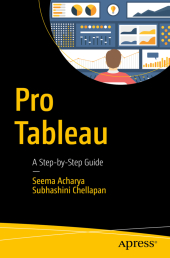 Neuerscheinungen 2016Stand: 2020-02-01 |
Schnellsuche
ISBN/Stichwort/Autor
|
Herderstraße 10
10625 Berlin
Tel.: 030 315 714 16
Fax 030 315 714 14
info@buchspektrum.de |

Seema Acharya, Subhashini Chellappan
(Beteiligte)
Pro Tableau
A Step-by-Step Guide
1st ed. 2016. xxiii, 845 S. 31 SW-Abb., 1032 Farbabb. 254 mm
Verlag/Jahr: SPRINGER, BERLIN; APRESS 2016
ISBN: 1-484-22351-9 (1484223519)
Neue ISBN: 978-1-484-22351-2 (9781484223512)
Preis und Lieferzeit: Bitte klicken
Leverage the power of visualization in business intelligence and data science to make quicker and better decisions. Use statistics and data mining to make compelling and interactive dashboards. This book will help those familiar with Tableau software chart their journey to being a visualization expert.
Pro Tableau demonstrates the power of visual analytics and teaches you how to:
Connect to various data sources such as spreadsheets, text files, relational databases (Microsoft SQL Server, MySQL, etc.), non-relational databases (NoSQL such as MongoDB, Cassandra), R data files, etc.
Write your own custom SQL, etc.
Perform statistical analysis in Tableau using R
Use a multitude of charts (pie, bar, stacked bar, line, scatter plots, dual axis, histograms, heat maps, tree maps, highlight tables, box and whisker, etc.)
What you´ll learn
Connect to various data sources such as relational databases (Microsoft SQL Server, MySQL), non-relational databases (NoSQL such as MongoDB, Cassandra), write your own custom SQL, join and blend data sources, etc.
Leverage table calculations (moving average, year over year growth, LOD (Level of Detail), etc.
Integrate Tableau with R
Tell a compelling story with data by creating highly interactive dashboards
Who this book is for
All levels of IT professionals, from executives responsible for determining IT strategies to systems administrators, to data analysts, to decision makers responsible for driving strategic initiatives, etc. The book will help those familiar with Tableau software chart their journey to a visualization expert.
Table of content
Chapter 1: Introducing Visualization and Tableau
Why Visualization?
What is Visualization?
Positioning of Tableau
Tableau product lines
File types in Tableau
.twb
.twbx
.tds
.tdsx
.tde
.tbm
Chapter 2: Working with Single and Multiple Data Sources
Desktop Architecture
Data Connection Page
Connect to a File
Excel
Open with legacy connection
Text
Microsoft Access
R data file (.rdata)
Connect to a Server
Microsoft SQL Server
MySQL
NoSQL Databases (MongoDB, Cassandra)
Metadata Grid
Using Data Extracts
All about Joins
Using Custom SQL
Using Data Blending
Chapter 3: Simplifying and Sorting your Data
Filtering on dimensions and measures
Soring on single dimension - Primary sort
Sorting on more than one dimension - Secondary Sort
Slicing your data by date
Discrete dates
Continuous dates
Organizing your data
Groups
Hierarchies
Sets
Static sets
Dynamic sets
Difference between groups and sets
Chapter 4: Measure Values and Measure Names
Using measure values and measure names in a view
Chapter 5: Using Quick Table Calculations in Tableau
Running Total
Percent of Total
Percentile
Rank
Moving average
Year over Year Growth
Level Of Detail (LOD) calculations
Chapter 6: Customizing your Data
String Calculations
Number Calculations
Date Calculations
Logical Calculations
Chapter 7: Statistics
Descriptive Statistics
Sum
Average
Min
Max
Count
Count(distinct)
Median
Standard Deviation
Variance
Using the Analytics Pane
Constant Lines
Average Lines
Five magical number summary
Box and whisker plot
Trend Lines
Forecast
Chapter 8: Chart Forms
Bar Chart
Pie chart
Line graph
Scatter Plot
Histogram
Heat Map
Tree Map
Highlight Table
Chapter 9: Advance Visualization Methods
Waterfall Charts
Gantt View
Bullet Graph Chapter 10: Dashboard and Stories
Creating an interactive dashboard
Adding Actions to your dashboard
Telling stories with data
Chapter 11: Integration of R with Tableau
Functions such as (SCRIPT_INT(), SCRIPT_REAL(),SCRIPT_BOOL(), SCRIPT_STR())
Data Mining
Affinity Analysis
K-means Clustering


